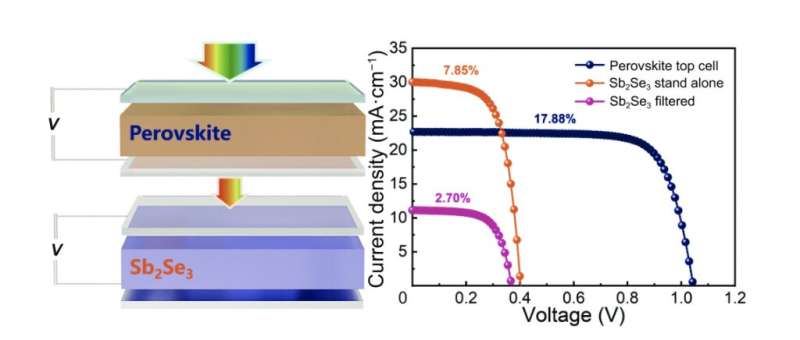This article has been reviewed according to Science X's editorial process and policies. Editors have highlighted the following attributes while ensuring the content's credibility:
fact-checked
proofread
Team fabricates tandem solar cell with power conversion efficiency greater than 20%

A research team has demonstrated for the first time a proof-of-concept tandem solar cell using antimony selenide as the bottom cell material and a wide-bandgap organic–inorganic hybrid perovskite material as the top cell material. The device achieved a power conversion efficiency of over 20%. This study shows that antimony selenide has great potential for bottom cell applications.
The research is published in the journal Energy Materials and Devices on March 4, 2024.
Photovoltaic technology, that harnesses sunlight and converts it into electricity, is popular because it provides a clean, renewable energy source. Scientists continue to work to improve the power conversion efficiency, or the measure of efficiency, in solar cells. They have achieved power conversion efficiencies of over 20% in conventional single-junction solar cells.
To achieve power efficiency above the Shockley-Queisser limit in single-junction solar cells would require much greater costs. However, the Shockley-Queisser limit of single-junction solar cells can be overcome through the fabrication of tandem solar cells. With tandem solar cells, researchers are able to gain a higher energy efficiency by stacking solar cell materials on top of each other.
The research team worked to create tandem solar cells, using a semiconductor called antimony selenide. Past research with antimony selenide has focused mainly on applications in single-junction solar cells. But the research team knew that from a band gap perspective, this semiconductor might prove to be an appropriate bottom cell material for tandem solar cells.
"Antimony selenide is a suitable bottom cell material for tandem solar cells. However, because of the rarity of reported tandem solar cells using it as a bottom cell, little attention has been paid to its application. We assembled a tandem solar cell with high conversion efficiency using it as the bottom cell to demonstrate the potential of this material," said Tao Chen, professor of Materials Science and Engineering at the University of Science and Technology of China.
Tandem solar cells are better able to absorb sunlight than single junction solar cells that use a single layer of semiconductor material. The tandem solar cells convert a larger portion of sunlight into electricity, so they are more energy efficient than single junction solar cells.
The team fabricated perovskite/antimony selenide tandem solar cells that have a transparent conducting electrode for an optimized spectral response. They were able to adjust the thickness of the transparent electrode layer of the top cell to obtain a high efficiency of greater than 17%. They optimized the antimony selenide bottom cell by introducing a double electron transport layer and achieved a power conversion efficiency of 7.58%.
When they mechanically assembled the top and bottom cells to create the four-terminal tandem solar cell, the power conversion efficiency exceeded 20.58%, which is higher than that of the independent subcells. Their tandem solar cell exhibits excellent stability with nontoxic compositional elements.
"This work provides a new tandem device structure and demonstrates that antimony selenide is a promising absorber material for bottom cell applications in tandem solar cells," said Chen.
Looking ahead, the team hopes to work toward a more integrated two-terminal tandem solar cell and further improve device performance. Chen added, "The high stability of antimony selenide provides great convenience for the preparation of two-terminal tandem solar cell, which means that it may have good results when paired with quite a few different types of top cell materials."
The research team includes Zhiyuan Cai, Huiling Cai, Yuehao Gu, Rongfeng Tang, Changfei Zhu, and Tao Chen from the University of Science and Technology of China, along with Jia Sun and Paifeng Luo from Hefei University of Technology.
More information: Zhiyuan Cai et al, Sb2Se3 as a bottom cell material for efficient perovskite/Sb 2Se 3 tandem solar cells, Energy Materials and Devices (2024). DOI: 10.26599/EMD.2024.9370027


















